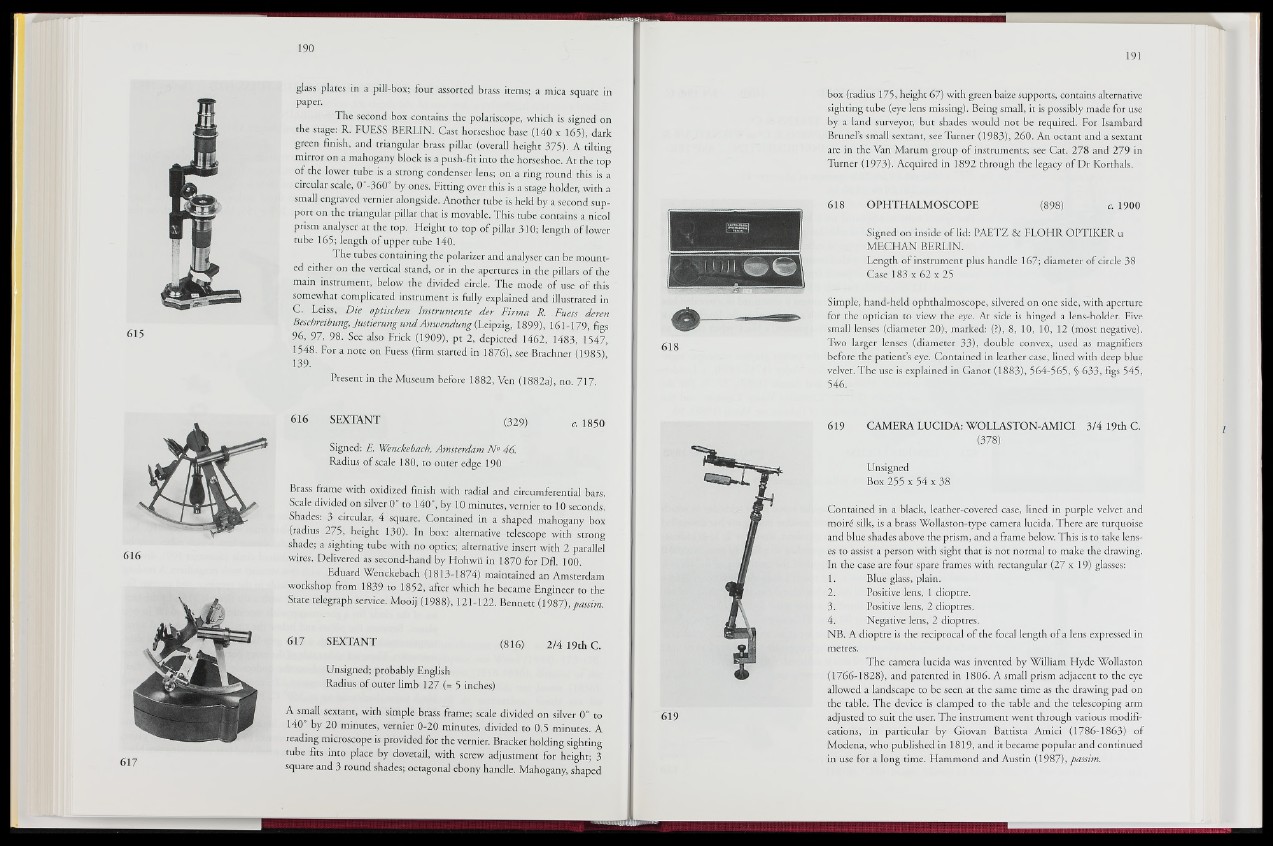
glass plates in a pill-box; four assorted brass items; a mica square in
paper.
The second box contains the polariscope, which is signed on
the stage: R. FUESS BERLIN. Cast horseshoe base (140 x 165), dark
green finish, and triangular brass pillar (overall height 375). A tilting
mirror on a mahogany block is a push-fit into the horseshoe. At the top
of the lower tube is a strong condenser lens; on a ring round this is a
circular scale, 0 -360 by ones. Fitting over this is a stage holder, with a
small engraved vernier alongside. Another tube is held by a second support
on the triangular pillar that is movable. This tube contains a nicol
prism analyser at the top. Height to top of pillar 310; length of lower
tube 165; length of upper tube 140.
The tubes containing the polarizer and analyser can be mounted
either on the vertical stand, or in the apertures in the pillars of the
main instrument, below the divided circle. The mode of use of this
somewhat complicated instrument is fully explained and illustrated in
C. Leiss, Die optischen Instrumente der Firma R. Fuess deren
Beschreibung, Justierung undAnwendung (Leipzig, 1899), 161-1/9, figs
96, 97, 98. See also Frick (1909), pt 2, depicted 1462, 1483, 1547,
1548. For a note on Fuess (firm started in 1876), see Brachner (1985)
139.
Present in the Museum before 1882, Yen (1882a), no. 71:,S;
616 SEXTANT (329); c, 1850
Signed: £. Wenckebach, Amsterdam N° 46.
Radius of scale 180, to outer edge 190
Brass frame with oxidized finish with radial and circumferential bars.
Scale divided on silver 0° to 140°, by 10 minutes, vernier to 10 seconds.
Shades: 3 circular, 4 square. Contained in a shaped mahogany box
(radius 275, height 130). In box: alternative telescope with strong
shade; a sighting tube with no optics; alternative insert with 2 parallel
wires. Delivered as second-hand by Hohwii in 1870 for Dfl. 100.
Eduard Wenckebach (1813-1874) maintained an Amsterdam
workshop from 1839 to 1852, after which he became Engineer to the
State telegraph service. Mooij (1988), 121-122. Bennett (1987), passim.
617 SEXTANT (816) 2/4 19th C.
Unsigned; probably English
Radius of outer limb 127 (= 5 inches)
A small sextant, with simple brass frame; scale divided on silver 0° to
140° by 20 minutes, vernier 0-20 minutes, divided to 0.5 minutes. A
reading microscope is provided for the vernier. Bracket holding sighting
tube fits into place by dovetail, with screw adjustment for height; 3
square and 3 round shades; octagonal ebony handle. Mahogany, shaped
box (radius 175, height 67) with green baize supports, contains alternative
sighting tube (eye lens missing). Being small, it is possibly made for use
by a land surveyor, but shades would not be required. For Isambard
Brunei’s small sextant, see Turner (1983), 260. An octant and a sextant
are in the Van Marum group of instruments; see Cat. 278 and 279 in
Turner (1973). Acquired in 1892 through the legacy of Dr Korthals.
618 OPHTHALMOSCOPE
&
618
(898) c. 1900
Signed on inside of lid: PAETZ & FLOHR OPTIKER u
MECHAN BERLIN.
Length of instrument plus handle 167; diameter of circle 38
Case 183 x 62 x 25
Simple, hand-held ophthalmoscope, silvered on one side, with aperture
for the optician to view the eye. At side is hinged a lens-holder. Five
small lenses (diameter 20), marked: (?), 8, 10, 10, 12 (most negative).
Two larger lenses (diameter 33), double convex, used as magnifiers
before the patient s eye. Contained in leather case, lined with deep blue
velvet. The use is explained in Ganot (1883), 564-565, § 633, figs 545,
546.
619
619 CAMERA LUCIDA: WOLLASTON-AMICI 3/4 19th C.
(378)
Unsigned
Box 255 x 54 x 38
Contained in a black, leather-covered case, lined in purple velvet and
moiré silk, is a brass Wollaston-type camera lucida. There are turquoise
and blue shades above the prism, and a frame below. This is to take lenses
to assist a person with sight that is not normal to make the drawing.
In the case are four spare frames with rectangular (27 x 19) glasses:
1. Blue glass, plain.
2. Positive lens, 1 dioptre.
3. Positive lens, 2 dioptres.
4. Negative lens, 2 dioptres.
NB. A dioptre is the reciprocal of the focal length of a lens expressed in
metres.
The camera lucida was invented by William Hyde Wollaston
(1766-1828), and patented in 1806. A small prism adjacent to the eye
allowed a landscape to be seen at the same time as the drawing pad on
the table. The device is clamped to the table and the telescoping arm
adjusted to suit the user. The instrument went through various modifications,
in particular by Giovan Battista Amici (1786-1863) of
Modena, who published in 1819, and it became popular and continued
in use for a long time. Hammond and Austin (1987), passim.